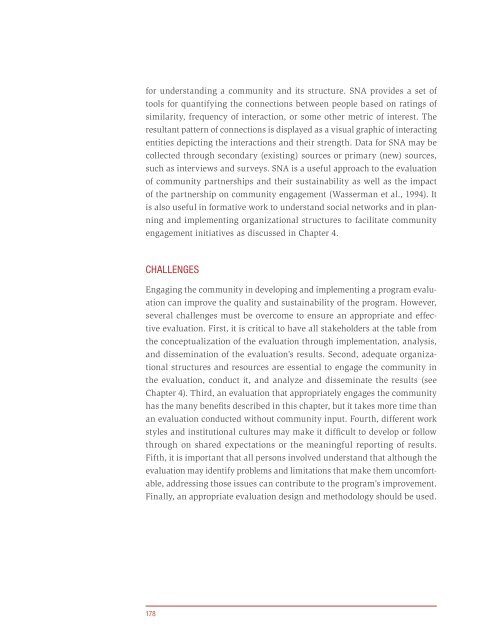Principles of Community Engagement (Second Edition)
Principles of Community Engagement (Second Edition)
Principles of Community Engagement (Second Edition)
Create successful ePaper yourself
Turn your PDF publications into a flip-book with our unique Google optimized e-Paper software.
for understanding a community and its structure SNA provides a set <strong>of</strong><br />
tools for quantifying the connections between people based on ratings <strong>of</strong><br />
similarity, frequency <strong>of</strong> interaction, or some other metric <strong>of</strong> interest The<br />
resultant pattern <strong>of</strong> connections is displayed as a visual graphic <strong>of</strong> interacting<br />
entities depicting the interactions and their strength Data for SNA may be<br />
collected through secondary (existing) sources or primary (new) sources,<br />
such as interviews and surveys SNA is a useful approach to the evaluation<br />
<strong>of</strong> community partnerships and their sustainability as well as the impact<br />
<strong>of</strong> the partnership on community engagement (Wasserman et al , 1994) It<br />
is also useful in formative work to understand social networks and in planning<br />
and implementing organizational structures to facilitate community<br />
engagement initiatives as discussed in Chapter 4<br />
CHALLENGES<br />
Engaging the community in developing and implementing a program evaluation<br />
can improve the quality and sustainability <strong>of</strong> the program However,<br />
several challenges must be overcome to ensure an appropriate and effective<br />
evaluation First, it is critical to have all stakeholders at the table from<br />
the conceptualization <strong>of</strong> the evaluation through implementation, analysis,<br />
and dissemination <strong>of</strong> the evaluation’s results <strong>Second</strong>, adequate organizational<br />
structures and resources are essential to engage the community in<br />
the evaluation, conduct it, and analyze and disseminate the results (see<br />
Chapter 4) Third, an evaluation that appropriately engages the community<br />
has the many benefits described in this chapter, but it takes more time than<br />
an evaluation conducted without community input Fourth, different work<br />
styles and institutional cultures may make it difficult to develop or follow<br />
through on shared expectations or the meaningful reporting <strong>of</strong> results<br />
Fifth, it is important that all persons involved understand that although the<br />
evaluation may identify problems and limitations that make them uncomfortable,<br />
addressing those issues can contribute to the program’s improvement<br />
Finally, an appropriate evaluation design and methodology should be used<br />
178

















